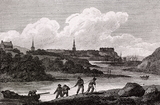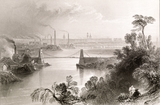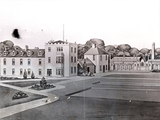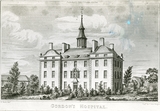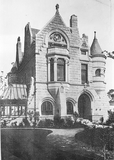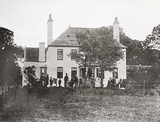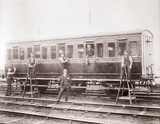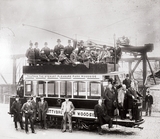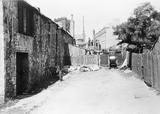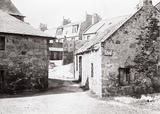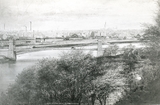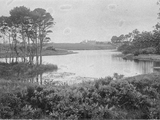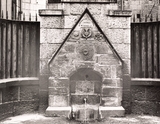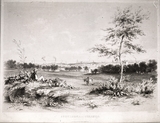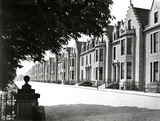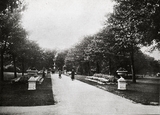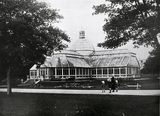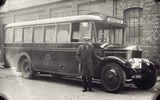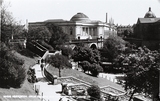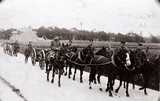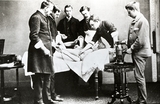|
Quick Search
|
Search Results
You searched for: Subject matches "Aberdeen - General" or its children
443 items
items as
The Wellington Suspension Bridge
67 The Wellington Suspension Bridge over the River Dee was built in 1829 by Samuel Brown and John Smith. It connects Ferryhill with the high bank of Craiglug to the south. Print dated 1850. The bridge, locally known as the 'Chain Bridge', was closed to traffic and pedestrians because of its poor condition before reopening after restoration in 2008. Lochhead Hydropathic
91 Lochhead was a mansion situated near Westburn Park. It was said to be the first hydropathic establishment in Scotland and featured Turkish and Medicated Baths. By the 1890s the building was occupied by the George Washington Wilson optical lantern slide export department. The building was demolished in 1932, and the grounds became part of Westburn Park. Gordon's Hospital
101 Gordon's Hospital from 1731, designed by William Adam, was a school for the education of orphaned boys, endowed by Robert Gordon. His statue, by John Cheere, is seen above the doorway. Although completed by 1739, it was not occupied by pupils until 1750. John Smith remodelled and extended the building in 1833. It became Robert Gordon's College in the 1880s. Rubislaw House
104 Rubislaw House, 50 Queen's Road, Aberdeen. It was designed by J.B. Pirie and built in 1886 for the builder, John Morgan. Fountainhall House
115 Fountainhall House, now 130 Blenheim Place, an 18th century two-storey house with period gateway and ironwork, commemorates, through its original name of Fountain Haugh, the days when reservoirs and cisterns dotted the area. The old 1706 cistern from Fountainhall is now in Duthie Park. GNSR railway carriage
136 Six men working on Third Class Great North of Scotland Railway carriage No. 128. Woodside electric tram
137 The inaugural procession on 23rd December 1899 for the electrification of the Woodside tram route, the first in Aberdeen to be modernised.
Lord Provost John Fleming is at the helm, with Tramways Convener Alexander Wilkie standing next to him, and Councillor Alexander Glass has his foot on the platform.
Next to Fleming and Wilkie, and above Glass, appears to be Alexander Lyon, provost between 1905-1908. Baillie James Taggart, also later to be provost, is the right-most figure in the back row on the roof of the car. Two to the left of Taggart may be James Walker, provost between 1903-1905.
James Alexander Bell, City Electrical Engineer for Aberdeen in the late 19th and early 20th centuries, is the bowler hatted figure on the stairs above Lord Provost Fleming.
This inauguration is detailed in an article titled 'Electric tramways in Aberdeen: Opening of Woodside section' in the Aberdeen Journal of 25th December 1899, page 7. It details the celebratory tram trip shown here and a luncheon in the Town and County Hall that followed. Granite yard
146 Local historian A. G. Duthie has been in touch to suggest that this photograph most likely shows a granite yard. Slabs of the rock can be seen by the wooden fence and the men are standing near small sheerleg cranes.
Brian Kennedy has also contact us to identify the location of the image. It is looking north west along the thoroughfare that is identified as Duthie's Brae on early Ordnance Survey maps. The tenements in the background are those on Nellfield Place. The smaller house on the left in the background was known as Home Cottage and was one of the first built on the street that was then called Holburn Place.
Maps indicate the buildings shown on the left were used as malt barns and later as storehouses. Duthie's Brae was just south of where Hardgate met Fonthill Terrace.
This photograph was likely taken by James Ritchie in 1917. There is another image on this website by Ritchie that looks south from a nearby position. Old Deeside Road
147 Local historian A.G. Duthie has been in touch to identify this image as the most easterly point of the Old Deeside Road.
The photograph is taken from the position of the modern day junction of Great Southern Road and Holburn Street. The house in the background is still visible today.
In his book The Old Deeside Road, G.M. Fraser writes, "The commencement of the old road at Hardgate is still, fortunately, to be seen, near Fonthill Road, at the group of ruinous houses connected with what was long known as Palmer's Brewery. The 'lie' of the old houses at the back of the brewery shows the run of the old road, two of the small, dilapidated buildings being clearly the eastmost houses of the old road just where it touched the Hardgate." (p. 19)
This scene was photographed for Aberdeen Public Library on 6th July 1917 by Mr. James Ritchie. Aberdeen Royal Infirmary, Foresterhill
150 Aberdeen Royal Infirmary, Foresterhill, opened in 1936.
This postcard image looks south east and shows the northern side of the general Royal Infirmary building. The photograph must have been taken from around the location of the University of Aberdeen School of Medicine building.
Much of these original buildings remain and and are now surrounded by newer additions to the Foresterhill complex. Rosemount Viaduct
154 Union Terrace looking towards Rosemount Viaduct. On the left is St. Mark's Church and on the right His Majesty's Theatre. In front of the theatre is the statue of William Wallace with Prince Albert at the left. Bishop's Loch
173 Bishop's Loch lies to the north of Aberdeen, just within the city boundary. A charter from the 12th century refers to the lands of Goul or Goval, where the Bishop of Aberdeen had his palace or residence on an island in Loch Goul, now called Bishop's Loch, where at one time the site was visible. The approach to the palace was by a drawbridge. At this time, the Bishops were engaged in developing the Chanonry in Old Aberdeen. Over time, the lands outside the Chanonry were sold off. This photograph shows a much larger expanse of water than now exists. The water level has been lowered and certain areas are silted up and there is lush growth of various wetland plants. Nearby, there is new housing and a sand gravel quarry. Many discussions took place about the possible creation of a nature reserve to encompass this loch and two other nearby lochs - Lochs Corby and Lily - and they were listed as Sites of Special Scientific Interest in October 1983. Well of Spa
175 In 1615 Dr. William Barclay wrote a treatise extolling the virtues of the Well of Spa and commending the use of its waters to invalids. Then George Jamesone, the artist, while suffering from calculus of the bladder found relief from the mineral qualities of the well. At the beginning of the 20th century, the well was removed and re-erected inside the wall of the old Royal Infirmary at Woolmanhill and water was introduced into it from another source. Later it was moved to a nearby site behind Aberdeen Central Library, beside the Denburn Car Park. View of Aberdeen from Cornhill
181 View of Aberdeen from Cornhill, c.1840. This picture was contained in a series of lithographs of Aberdeen published in 1840 by J and D Nichol, booksellers, Montrose. The elevated position of Cornhill provided one of the best points of view over the city. The idyllic rural scene in the foreground is in contrast to the array of smoking chimneys in the distance, interspersed with the spires of various buildings. In the middle is Broadford Textile Works with Hutcheon Street on the left. On the far right, there is the tall chimney of Rubislaw Bleachfield Works, which was demolished in July 1908. The spires belong to the East and West Churches of St. Nicholas, and the Tolbooth while, in the centre, there are the four turrets of the central tower of Marischal College and the tower of the North Church. The chimneys were evidence of the extent and importance of manufacturing in the city, while the western suburbs were the most attractive, with beautiful villas whose residents were often those citizens whose wealth came from these industries. Rubislaw Terrace
236 James Skene of Rubislaw was responsible for this fine row of town houses situated in the west end of the city. The houses, now mostly all offices, alternate in pairs. The original plan of design in 1852 was by James Giles, artist, and Messrs. MacKenzie and Matthews, architects. The street still retains a dignified appearance with some attractive architectural features and elevations. Victoria Park
241 In 1871 Aberdeen Town Council decided to convert nearly 14 acres of Glennie's Parks, which had been used for cattle grazing, into a public recreation ground - Aberdeen's first public park.
Aberdeen's lack of a public park up to this point had become a contentious issue. For example, newspaper reports indicate that those opposed to the Municipality Extension Act of 1871 (which extended the boundary of the city, brought the functions of the Police Commissioners under the Council and incorporated the gasworks) repeatedly suggested that the expense involved in the new bill would be better used in the creation of a much wanted public park.
It is not unreasonable to suppose that this debate, and criticism of the Council, hastened the creation of Victoria Park. While work likely begun in 1871, it was not until March 1873 that the Improvements Committee of the Council recommended that the new park should be called "Victoria Park". At the same time, they also outlined a series of 13 rules and regulations for agreement by the full Council. There does not appear to have been an official opening for the new amenity.
Glennie's Park was not the only site considered for Aberdeen's first public park. Interest in such an undertaking was increasing at the same time as work was underway to divert the River Dee and improve the harbour. The new ground created in this latter project, encompassing the old, more northerly course of the river and the Inches, was a much proposed location for a park. Following the creation of Victoria Park this newly leveled ground was instead given over for buildings related to the expanding fishing industry.
A nurseryman called Robert Walker (1848-1930), originally from Perth, was chosen out of 450 candidates to be the city's first public park keeper and appointed to Victoria Park. He was likely largely responsible for the park's initial layout and appearance. His Press & Journal obituary (21/04/1930, p.6) suggests that prior to his appointment the site was "little better than a waste space".
Walker subsequently laid out Westburn Park, Stewart Park, Union Terrace Gardens and the Promenade. He also advocated and pioneered the planting of street trees. He served the Corporation for 46 years, retiring in 1919, and must be considered one of the unsung heroes of Aberdeen history.
This photograph, taken around 1900, shows one of the main paths leading to a large granite fountain, which was designed by J.B. Pirie. It is built of 14 different types of granite and was presented by the granite polishers and master builders of the city.
Since the park is almost in the city centre, it is an oasis of peace with its mature trees and, in spring, there are masses of flowering bulbs scattered through the grass. The old Winter Gardens, Duthie Park
242 The original Winter Gardens was known as the Palm House. It was designed by the then city architect, John Rust (1844-1919), and erected from 1899. It was constructed from St. Petersburg redwood and cost £1,550 in total. It officially opened on 1st August 1900.
The roof of the Palm House suffered extensive damage during a storm in May 1969 and after 70 years of public use the building had to be demolished and rebuilt. The new Winter Gardens was opened by Lord Provost Robert S. Lennox on 8th April 1970. The 'Aberdeen' Bus 1930s
267 Bus driver with his Albion motor bus belonging to the Deeside Omnibus Service, 1930s. This coach was one of several in the fleet of the Ballater based Strachan's Company. For many years, these coaches regularly departed from the SMT depot in Bon Accord Square before journeying to Banchory and beyond. Strachan's Deeside Omnibus Service operated on the Royal Deeside route for many years with Alexanders. This particular 'Aberdeen' bus looks in good condition with gleaming bodywork. Note the roof-rack for any large pieces of luggage. Union Terrace Gardens
268 Union Terrace Gardens looking towards the War Memorial at the Cowdray Hall. Soldiers of Aberdeen Battery
269 Soldiers of Aberdeen Battery on foot and with horses. They are most likely pulling light field guns linked together in pairs. Aberdeen Royal Infirmary, c.1870
280 An early surgical operation at Aberdeen Royal Infirmary. The fourth figure from the left is Dr Alexander Ogston, the eminent surgeon. An assistant attends to the carbolic spray worked by hand, as used by Lister for the first time in Edinburgh in 1869. The era of sterilised gowns, caps, masks and gloves with antiseptic of dressings, instruments or even the fingers on which Lister later insisted, had not yet arrived. |



